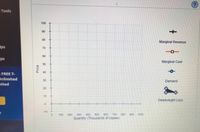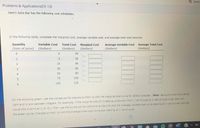
ENGR.ECONOMIC ANALYSIS
14th Edition
ISBN: 9780190931919
Author: NEWNAN
Publisher: Oxford University Press
expand_more
expand_more
format_list_bulleted
Question
A publisher faces the following demand schedule for the next novel from one of its popular authors:
|
|
Quantity Demanded
|
|---|---|
|
(Dollars)
|
(Copies)
|
| 100 | 0 |
| 90 | 100,000 |
| 80 | 200,000 |
| 70 | 300,000 |
| 60 | 400,000 |
| 50 | 500,000 |
| 40 | 600,000 |
| 30 | 700,000 |
| 20 | 800,000 |
| 10 | 900,000 |
| 0 | 1,000,000 |
The author is paid $2 million to write the novel, and the marginal cost of publishing the novel is a constant $10 per copy.
Complete the second, fourth, and fifth columns of the following table by computing total revenue, total cost, and profit at each quantity.
|
Quantity
|
Total Revenue
|
Marginal Revenue
|
Total Cost
|
Profit
|
|---|---|---|---|---|
|
(Copies)
|
(Dollars)
|
(Dollars)
|
(Dollars)
|
(Dollars)
|
| 0 |
|
|
|
|
|
|
||||
| 100,000 |
|
|
|
|
|
|
||||
| 200,000 |
|
|
|
|
|
|
||||
| 300,000 |
|
|
|
|
|
|
||||
| 400,000 |
|
|
|
|
|
|
||||
| 500,000 |
|
|
|
|
|
|
||||
| 600,000 |
|
|
|
|
|
|
||||
| 700,000 |
|
|
|
|
|
|
||||
| 800,000 |
|
|
|
|
|
|
||||
| 900,000 |
|
|
|
|
|
|
||||
| 1,000,000 |
|
|
|
Which of the following quantity–price combinations would a profit-maximizing publisher choose?
(Note: If the publisher is indifferent between more than one choice, select all of the indifferent combinations.)
Check all that apply.
300,000 copies at a price of $70
400,000 copies at a price of $60
500,000 copies at a price of $50
600,000 copies at a price of $40
Complete the third column of the previous table by computing marginal revenue. (Hint: Recall that MR=ΔTRΔQMR=ΔTRΔQ.)
True or False: At each quantity, marginal revenue is less than the price.
True
or
False
pic 2 :
Use the black points (plus symbol) to graph the marginal revenue from the 100,000th, 200,000th, 300,000th, 400,000th, 500,000th, and 600,000th copy of the novel. Remember to plot from left to right and to plot between integers. For example, if the marginal revenue of increasing production from 100,000 copies to 200,000 copies were 10, then you would plot a point at (150, 10). Next use the orange line (square symbol) to graph the marginal-cost curve faced by the publisher. Finally, use the blue points (circle symbol) to graph demand at the following quantities (in thousands): 0, 100, 200, 300, 400, 500, 600, 700, 800, 900, and 1,000.
The marginal-revenue and marginal-cost curves intersect at a quantity of (?) copies.
On the previous graph, use the black triangle (plus symbols) to shade the area representing deadweight loss .
If the author were paid $3 million instead of $2 million to write the book, the publisher would (?) the price it charges for a copy of the novel.
Suppose the publisher was not profit-maximizing but was concerned with maximizing economic efficiency, and the author of a novel was paid $2 million to write the book.
In this case, the publisher would charge ($) ?
for a copy of the novel and earn a profit of ( $) ?
(Note: If the publisher experiences a loss, be sure to enter a negative number for profit.)

Transcribed Image Text:Tools
100
06
80
Marginal Revenue
ips
70
60
ps
Marginal Cost
50
40
FREE 7-
Inlimited
30
Demand
nited
10
Deadweight Loss
-10
100
200
300
400
500
600
700
800
900
1000
Quantity (Thousands of copies)
Price
20

Transcribed Image Text:Q Searc
Problems & Applications(Ch 13)
Jane's Juice Bar has the following cost schedules:
In the following table, complete the marginal cost, average variable cost, and average total cost columns.
Quantity
Variable Cost
Total Cost
Marginal Cost
Average Variable Cost
Average Total Cost
(Vats of juice)
(Dollars)
(Dollars)
(Dollars)
(Dollars)
(Dollars)
0.
30
1
35
2
15
45
30
60
4
50
80
75
105
5.
105
135
On the following graph, use the orange points (square symbol) to plot the marginal-cost curve for Jane's Juice Bar. (Note: Be sure to plot from left to
right and to plot between integers. For example, if the marginal cost of increasing production from 1 vat of juice to 2 vats of juice is $5, then you
would plot e point at (1.5, 5).) Then use the purple points (diamond symbol) to plot the average-variable cost curve starting at 1 vat of juice, and use
the green points (triangle symbol) to plot the average-total-cost curve also starting at 1 vat of juice.
3.
Expert Solution
This question has been solved!
Explore an expertly crafted, step-by-step solution for a thorough understanding of key concepts.
This is a popular solution
Trending nowThis is a popular solution!
Step by stepSolved in 5 steps with 4 images

Knowledge Booster
Learn more about
Need a deep-dive on the concept behind this application? Look no further. Learn more about this topic, economics and related others by exploring similar questions and additional content below.Similar questions
- ABC Cosmetic is going to launch a new special cleansing cream for men. It has aconstant marginal cost of $30 and the estimated price elasticity of demand is –4/3.What price should ABC Cosmetic charge for the cream? Show your calculation.arrow_forwardThe demand function of dog breeders for electric dog polishers is qb = max{200−p, 0}, and the demand function of pet owners for electric dog polishers is qo = max{90 − 4p, 0}. (a) At price 150, what is the price elasticity of dog breeders’ demand for electric dog polishers? (it's a negative number) (b) At price 15, what is the price elasticity of pet owner’ demand for electric dog polishers? (it's a negative number) (c) Find a nonzero price at which there is positive total demand for dog polishers and at which there is a kink in the demand curve. $_____. What is the market demand function for prices below the kink. What is the market demand function for prices above the kink? ______ + Parrow_forwardIf the price is given as 20 per unit and the given quantity is $150 billion Find the Total revenuearrow_forward
- Which of the following companies are most likely to face a nearly horizontal demand curve? Group of answer choices Companies (like Netflix) offering programs on television or computers Companies offering search engines on the Internet clothing retail stores offering their goods on the Internet The wholesale oil industry.arrow_forwardQuestion 1 Sal's Streaming Company streams TV shows to subscribers in the US and Canada. Demand is Qus 50 (1/3)Pus - QCA 80 (2/3)P CA = - where Q's are in thousands of subscriptions per year and P's are the subscription prices per year. The cost of providing Q units of service is given by TC = 1000 + 30Q, where Q = Qus+ QCA (a) What are the profit-maximizing prices and quantities for the US and Canadian markets? (b) As a consequence of a new VPN service that Facebook has developed, subscribers in Canada are now able to get the US streams and vice versa, so Sal can charge only a single price. What is the profit-maximizing single price that he should charge? (c) In which situation is Sal better off? In terms of consumers' surplus which situation do people in Canada prefer and which do people in the US prefer? Why?arrow_forwardFeedback Imagine that the flat-screen TV market is made up of one large firm that leads the industry and sets its own price first, and another firm that follows the leader when deciding its own profit-maximizing strategy. The leader has a cost function of c₁ (91) = 5q1, and the follower has a cost function of CF (ar) = 4, where Q =q₁ + qr. Total market demand for flat-screen TVs is given by the function Q = 250.00-2p. Calculate the following values: Leading firm's production: q = Follower firm's production: qp = Equilibrium price: p= $49.37 9 OF 16 QUESTIONS COMPLETED 118.33 32.92 (Round to two decimals if necessary.) (Round to two decimals if necessary.) (Round to two decimals if necessary.) See Hint 4 VIEW SOLUTION SUBMIT ANSWERarrow_forward
- Your company operates in a perfectly competitivemarket. You have been told that advertising can help youincrease your sales in the short run. Would you create anaggressive advertising campaign for your product?arrow_forwardThe widget market is competitive and includes no transaction costs. Five suppliers are willing to sell one widget at the following prices: $26, $14, $10, $5, and $3 (one seller at each price). Five buyers are willing to buy one widget at the following prices: $10, $14, $26, $34, and $42 (one buyer at each price). For each price shown in the following table, use the given information to enter the quantity demanded and quantity supplied. Price Quantity Demanded Quantity Supplied ($ per widget) (widgets) (widgets) $3 $5 $10 $14 $26 $34 $42 In this market, the equilibrium price will be per widget, and the equilibrium quantity will be widgets.arrow_forwardSuppose you own a tax preparation services company, with fixed costs of $3,000/month and marginal costs of $25/appt.If the price is $60/appt, 500 appointments would be sold. If the price is $50/appt, 760appointments would be sold. a.)Use these figures to calculate the price elasticity of demand for your services. b.)Calculate the monthly profits and profit margins (profit/revenue) associated with the price of $60/appt and $50/appt. c.)Given these calculations, what price should you charge for your services, $50/apptor $60/appt? Explainarrow_forward
- please answer in text form and in proper format answer with must explanation , calculation for each part and steps clearlyarrow_forwardSuppose that the demand for a product is given by the following demand function: Q = 500 -3P A. To sell 200 units, what price should you charge?arrow_forwardQ1. Given cost function f(x) = 1/2(c)(x2), where c>0, and demand curve y(z) = z-a, where a > 1 a). Compute price elasticity of demand. b). Draw a diagram showing marginal cost and marginal revenue c). Find price and output that maximize profits d). Find the markup (price divided by marginal cost). Does it increase or decrease based on elasticity of demand?arrow_forward
arrow_back_ios
SEE MORE QUESTIONS
arrow_forward_ios
Recommended textbooks for you

 Principles of Economics (12th Edition)EconomicsISBN:9780134078779Author:Karl E. Case, Ray C. Fair, Sharon E. OsterPublisher:PEARSON
Principles of Economics (12th Edition)EconomicsISBN:9780134078779Author:Karl E. Case, Ray C. Fair, Sharon E. OsterPublisher:PEARSON Engineering Economy (17th Edition)EconomicsISBN:9780134870069Author:William G. Sullivan, Elin M. Wicks, C. Patrick KoellingPublisher:PEARSON
Engineering Economy (17th Edition)EconomicsISBN:9780134870069Author:William G. Sullivan, Elin M. Wicks, C. Patrick KoellingPublisher:PEARSON Principles of Economics (MindTap Course List)EconomicsISBN:9781305585126Author:N. Gregory MankiwPublisher:Cengage Learning
Principles of Economics (MindTap Course List)EconomicsISBN:9781305585126Author:N. Gregory MankiwPublisher:Cengage Learning Managerial Economics: A Problem Solving ApproachEconomicsISBN:9781337106665Author:Luke M. Froeb, Brian T. McCann, Michael R. Ward, Mike ShorPublisher:Cengage Learning
Managerial Economics: A Problem Solving ApproachEconomicsISBN:9781337106665Author:Luke M. Froeb, Brian T. McCann, Michael R. Ward, Mike ShorPublisher:Cengage Learning Managerial Economics & Business Strategy (Mcgraw-...EconomicsISBN:9781259290619Author:Michael Baye, Jeff PrincePublisher:McGraw-Hill Education
Managerial Economics & Business Strategy (Mcgraw-...EconomicsISBN:9781259290619Author:Michael Baye, Jeff PrincePublisher:McGraw-Hill Education


Principles of Economics (12th Edition)
Economics
ISBN:9780134078779
Author:Karl E. Case, Ray C. Fair, Sharon E. Oster
Publisher:PEARSON

Engineering Economy (17th Edition)
Economics
ISBN:9780134870069
Author:William G. Sullivan, Elin M. Wicks, C. Patrick Koelling
Publisher:PEARSON

Principles of Economics (MindTap Course List)
Economics
ISBN:9781305585126
Author:N. Gregory Mankiw
Publisher:Cengage Learning

Managerial Economics: A Problem Solving Approach
Economics
ISBN:9781337106665
Author:Luke M. Froeb, Brian T. McCann, Michael R. Ward, Mike Shor
Publisher:Cengage Learning

Managerial Economics & Business Strategy (Mcgraw-...
Economics
ISBN:9781259290619
Author:Michael Baye, Jeff Prince
Publisher:McGraw-Hill Education